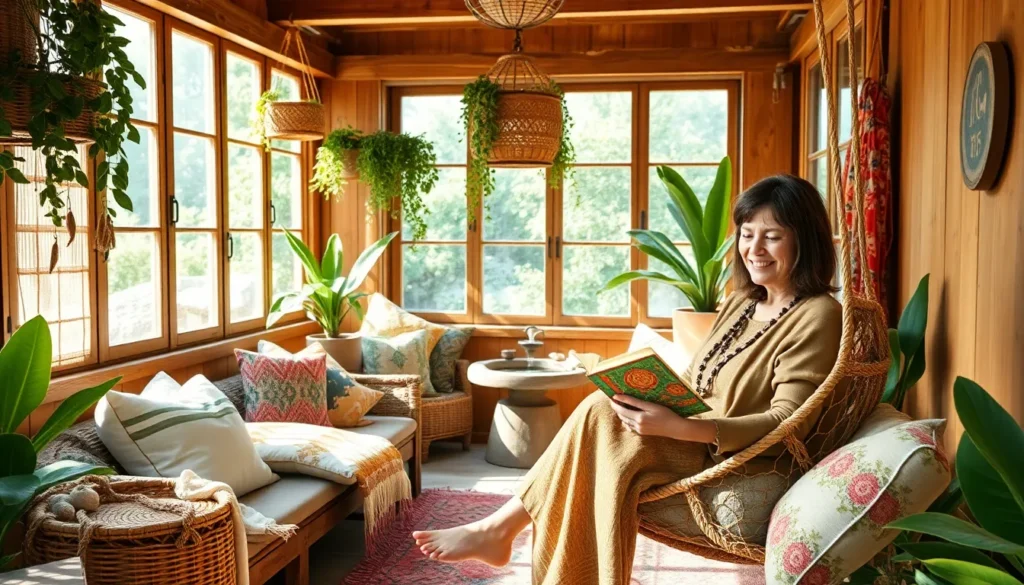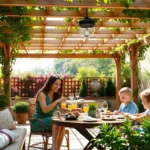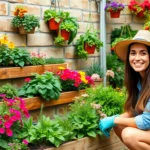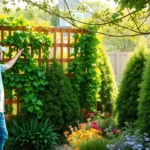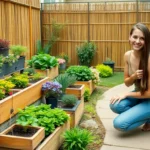We’ve all dreamed of having that perfect sanctuary where nature meets comfort – a garden room that serves as our personal retreat from the daily hustle. Whether you’ve recently added a garden room to your property or you’re looking to transform an existing space into something truly special, the decorating possibilities are endless and exciting.
Your garden room isn’t just another space to furnish; it’s an opportunity to create a unique environment that blends indoor comfort with outdoor serenity. From cozy reading nooks surrounded by lush plants to elegant dining areas that showcase your garden’s beauty, we’ll explore creative ideas that’ll help you maximize both style and functionality.
The key to successful garden room decoration lies in understanding how to balance aesthetics with practicality while creating a seamless connection between your indoor and outdoor spaces. Let’s jump into inspiring ideas that’ll transform your garden room into the stunning retreat you’ve always envisioned.
Choose a Design Theme That Reflects Your Personal Style
Your garden room’s design theme sets the foundation for every decorating decision you’ll make. We’ve found that selecting a cohesive style creates visual harmony while expressing your unique personality in this special outdoor sanctuary.
Bohemian Paradise With Colorful Textiles and Plants
Bohemian garden rooms embrace vibrant patterns and lush greenery to create an eclectic retreat. Layer colorful throw pillows in jewel tones across low seating areas, mixing paisley prints with geometric designs and tribal patterns. Drape flowing fabrics like silk scarves or lightweight tapestries from the ceiling to create intimate nooks that filter natural light beautifully.
Plants become living art in bohemian spaces, so we recommend grouping potted specimens at varying heights using vintage plant stands, woven baskets, and repurposed crates. Hanging planters with trailing vines like pothos or string of hearts add vertical interest while softening hard architectural lines. Macrame plant hangers perfectly complement this free spirited aesthetic.
Incorporate global treasures such as Moroccan lanterns, Indian brass vessels, or handwoven textiles from local artisans. These authentic pieces tell stories while adding cultural richness to your garden room’s bohemian atmosphere.
Modern Minimalist With Clean Lines and Neutral Tones
Modern minimalist garden rooms focus on simplicity and functionality through carefully curated elements. Choose furniture with sleek silhouettes in materials like powder coated steel, teak, or concrete that weather beautifully outdoors. Stick to a neutral color palette of whites, grays, and natural wood tones to maintain visual calm.
Storage answers should remain hidden or seamlessly integrated into your design scheme. Built in benches with concealed compartments serve dual purposes while maintaining clean sightlines throughout the space. Select planters in geometric shapes made from materials like fiber cement or cor ten steel for architectural interest.
Lighting becomes sculptural in minimalist garden rooms, so we suggest installing linear LED strips under seating or choosing pendant lights with simple geometric forms. This approach creates ambient illumination without cluttering your carefully planned aesthetic.
Rustic Farmhouse With Reclaimed Wood and Vintage Accents
Rustic farmhouse garden rooms celebrate natural materials and weathered finishes that develop character over time. Reclaimed barn wood creates stunning accent walls or ceiling treatments that instantly add warmth and texture. We love pairing this aged wood with wrought iron hardware and vintage mason jar lighting fixtures.
Furniture pieces should feel substantial and lived in, such as distressed wooden benches, galvanized metal planters, and antique wheelbarrows repurposed as unique garden features. Hunt for authentic vintage finds at flea markets and estate sales to discover one of a kind treasures like old milk jugs converted to vases or wooden crates transformed into shelving.
Color schemes in farmhouse garden rooms typically feature muted earth tones like sage green, cream, and warm browns. These natural hues complement the organic textures while creating a cozy atmosphere that feels both timeless and inviting.
Create Comfortable Seating Areas for Relaxation
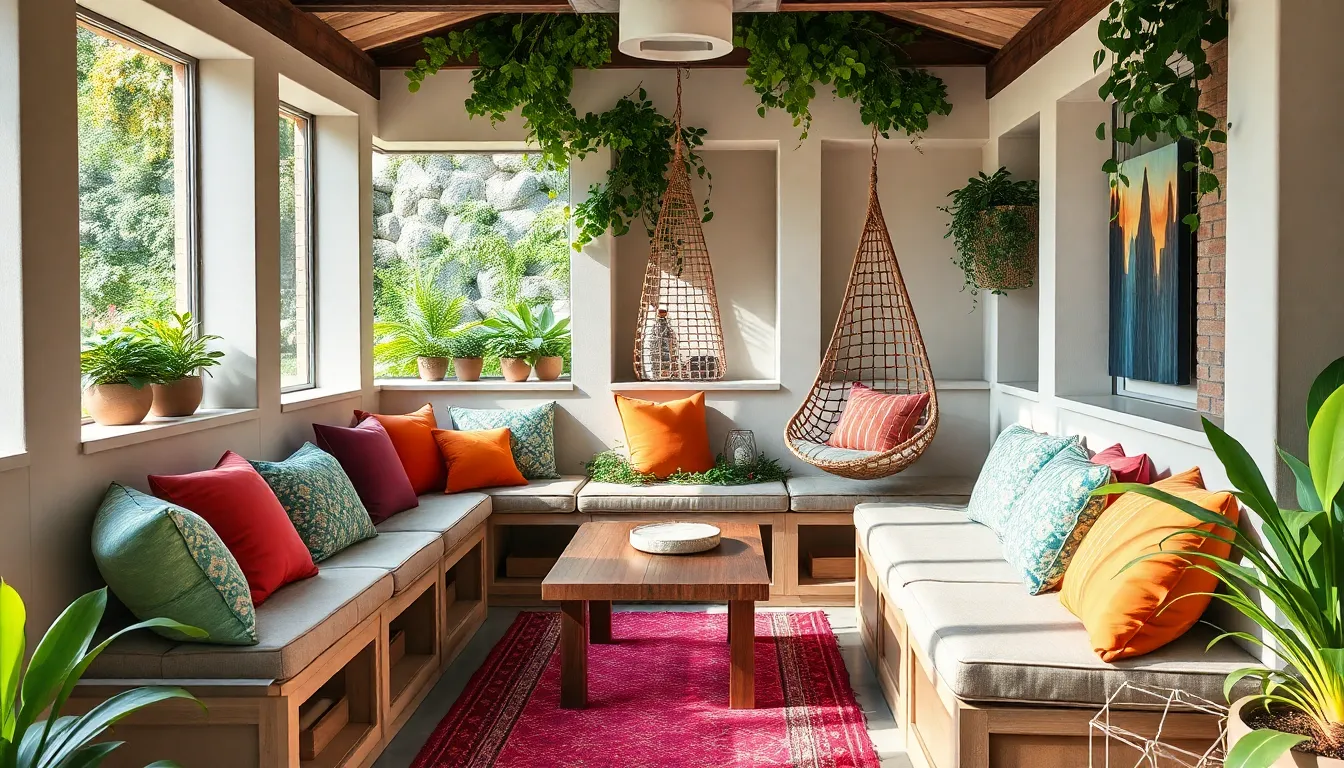
Comfortable seating transforms your garden room into a true sanctuary where relaxation becomes effortless. We’ll explore three key approaches to create inviting spaces that encourage you to unwind and enjoy your natural surroundings.
Add Plush Outdoor Cushions and Throw Pillows
Vibrant colors and natural materials like cotton or linen instantly add warmth and texture to any garden room seating arrangement. We recommend layering different sized cushions to create visual depth while maintaining comfort for extended lounging sessions.
Weather-resistant fabrics ensure your investment lasts through seasonal changes while maintaining their fresh appearance. Choose patterns that complement your overall design theme, whether you’re embracing bohemian eclecticism or rustic farmhouse charm.
Mix and match textures by combining smooth cotton with textured linen or adding woven elements that echo the natural surroundings. Strategic placement of throw pillows on benches, chairs, or floor cushions creates multiple seating options for different activities and group sizes.
Install Built-in Benches With Storage Underneath
Built-in benches provide permanent seating answers while maximizing your garden room’s functionality through hidden storage compartments. We suggest positioning these benches along walls or under windows to create cozy nooks that take advantage of natural light and views.
Storage compartments keep garden tools, extra cushions, or seasonal decorations neatly organized and easily accessible. Design the bench height to accommodate standard cushions while ensuring comfortable seating for adults of various heights.
Materials like reclaimed wood or weather-treated lumber align with rustic themes while painted finishes can complement modern minimalist aesthetics. Consider adding hinged tops with soft-close mechanisms to prevent slamming and ensure safe operation around children.
Position Hanging Chairs or Swing Seats
Hanging chairs create serene reading nooks that gently sway with natural breezes, adding movement and tranquility to your garden room experience. We recommend installing these suspended seats in corners or under structural beams where they won’t interfere with foot traffic.
Swing seats offer versatile seating that appeals to both adults and children, making your garden room a welcoming space for the entire family. Choose models with weather-resistant cushions and sturdy hanging hardware rated for outdoor use.
Position these suspended seating options near plants or trees to enhance the natural ambiance while creating intimate conversation areas. Consider the swing radius when planning placement to ensure adequate clearance from walls, furniture, and decorative elements.
Incorporate Living Elements to Enhance the Natural Feel
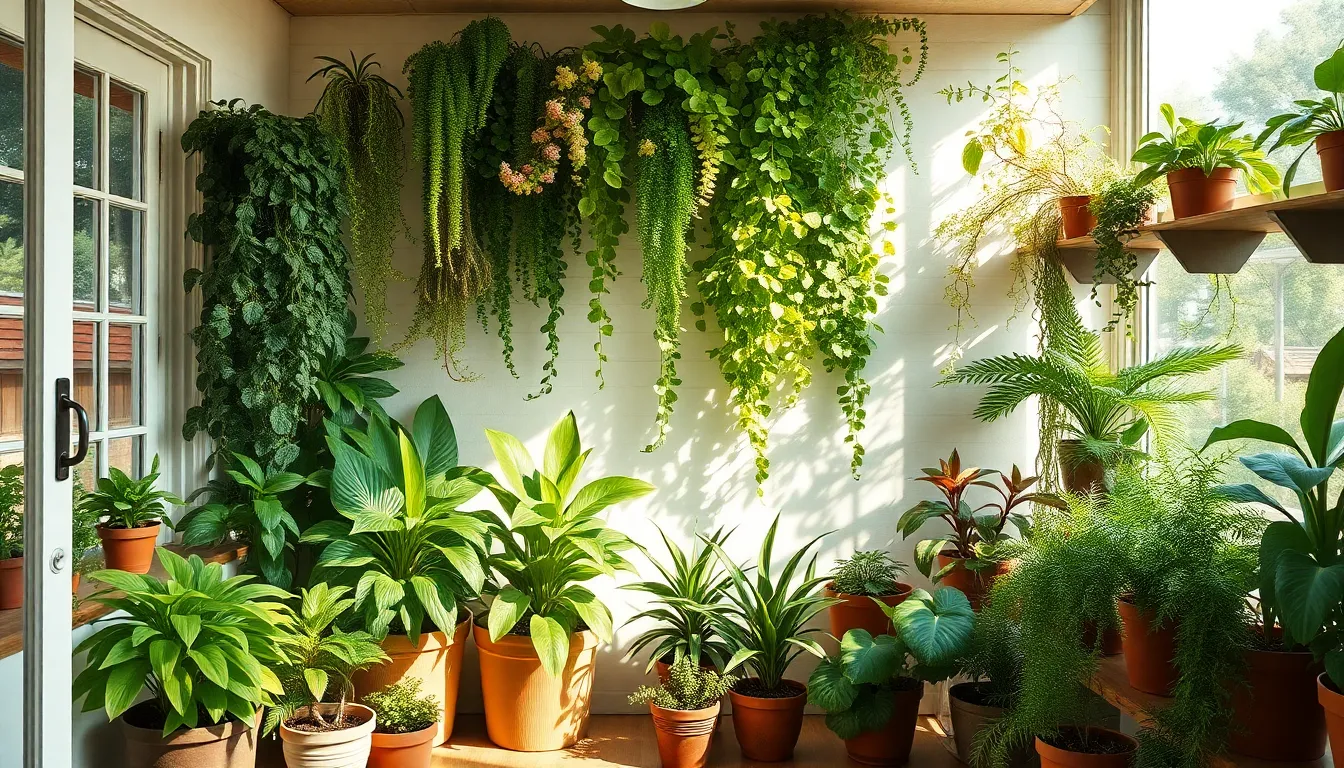
We can truly bring the outdoors inside by strategically adding plants and greenery throughout our garden room. Living elements create a seamless connection between our interior space and the natural garden beyond.
Install Vertical Gardens on Interior Walls
Vertical gardens maximize our green space without claiming valuable floor area in the room. These living walls create stunning focal points while adding lush, natural ambiance to any interior wall surface. We can feature various plants in our vertical gardens, from delicate ferns to cascading flowering vines that add both texture and vibrant color to the space.
Installing these green installations transforms bare walls into breathing artwork. Plants naturally purify the air while creating visual depth and interest throughout the room. We should consider the lighting requirements of different plant varieties when planning our vertical garden placement.
Add Potted Plants in Various Heights and Textures
Potted plants in different sizes create depth and visual interest throughout our garden room design. We can position tall houseplants or small trees near windows and corners where they’ll receive adequate natural light. Medium and smaller pots work perfectly to fill in spaces between furniture and along shelving areas.
Mixing broad leaf plants with trailing or spiky foliage enhances the botanical theme we’re creating. This variety connects our interior space directly with the outdoor garden environment. We should select containers that complement our chosen design theme while ensuring proper drainage for plant health.
Create an Indoor Herb Garden for Function and Beauty
Indoor herb gardens provide both visual appeal and practical culinary benefits for our garden room. We can choose pots that match our overall style and place them on shelves or window sills where they’ll receive ample sunlight. Fresh herbs like basil, rosemary, and thyme not only look beautiful but also provide aromatic elements to our space.
This functional greenery encourages a complete sensory experience in our garden room retreat. Growing our own herbs creates a direct connection to the cultivation aspect of gardening. We can harvest fresh ingredients while enjoying the natural beauty these plants bring to our indoor environment.
Install Proper Lighting for Ambiance and Functionality
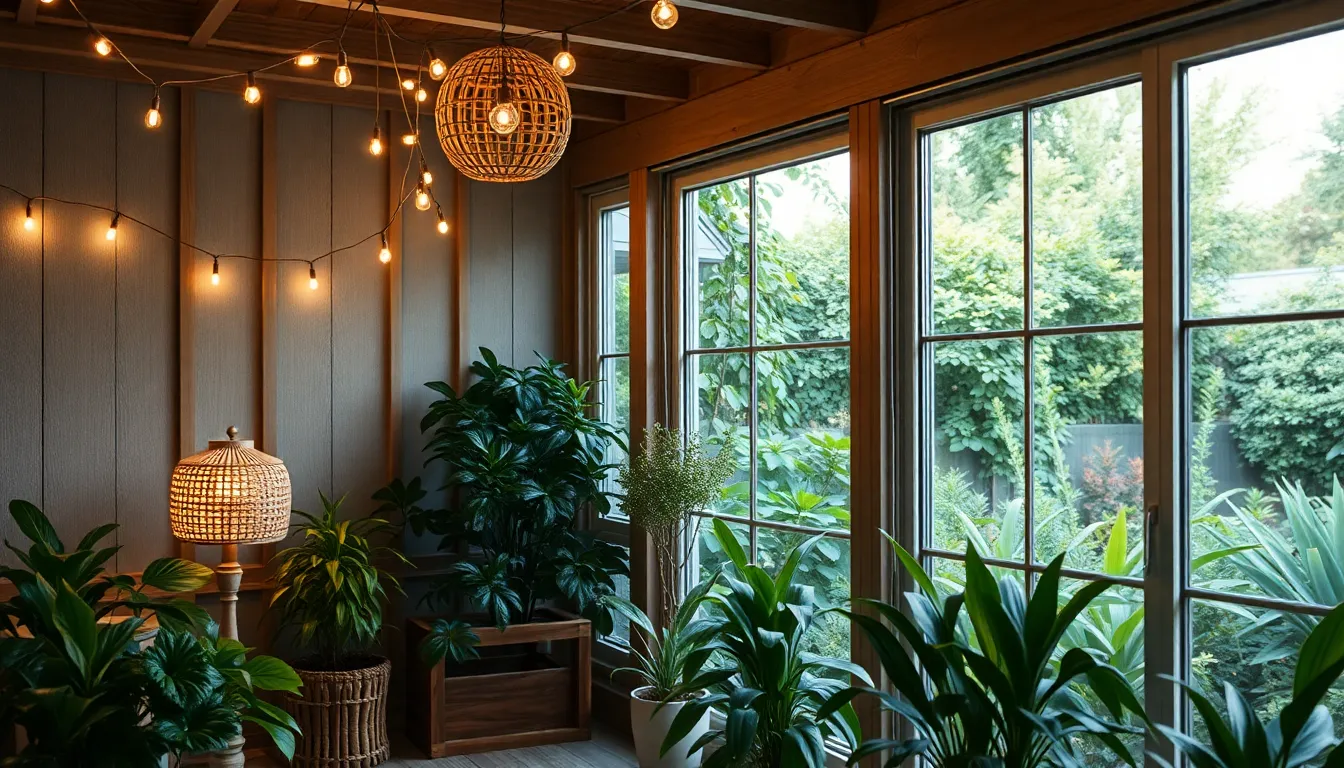
Proper lighting transforms your garden room from a simple space into a captivating environment that functions beautifully both day and night. We’ll explore three essential lighting strategies that combine natural and artificial sources to create the perfect atmosphere for any occasion.
Hang String Lights for Magical Evening Atmosphere
String lights create an enchanting ambiance that instantly transforms your garden room into a magical retreat. We recommend installing warm white LED string lights along the ceiling perimeter or draping them across exposed beams to create a canopy effect. These versatile fixtures provide soft illumination that’s perfect for evening relaxation or intimate gatherings.
Position the lights at varying heights to add visual interest and depth to your space. We suggest using timer controlled options that automatically illuminate at dusk, ensuring your garden room maintains its magical quality without constant manual adjustment. Weather resistant string lights work best for rooms with high humidity or temperature fluctuations, extending their lifespan and maintaining consistent performance.
Add Floor Lamps With Warm LED Bulbs
Floor lamps equipped with warm LED bulbs provide targeted lighting that complements your garden room’s natural surroundings. We recommend choosing fixtures with adjustable brightness settings, allowing you to customize the lighting intensity based on different activities like reading, dining, or socializing. Warm LED bulbs in the 2700K to 3000K range create a cozy atmosphere that enhances the connection between indoor comfort and outdoor tranquility.
Select floor lamps with natural materials like bamboo, rattan, or wood to maintain consistency with your garden room’s organic aesthetic. We suggest positioning these lamps in corners or beside seating areas to create intimate lighting zones throughout the space. Battery powered options offer flexibility in placement without requiring electrical outlets, making them ideal for rooms with limited wiring.
Install Skylights or Large Windows for Natural Light
Skylights and large windows maximize natural light penetration, creating a seamless integration between your garden room and the outdoor environment. We recommend installing skylights on slanted roofs to accommodate tall houseplants or small trees while flooding the space with daylight. These architectural features reduce dependence on artificial lighting during daytime hours and create ever-changing lighting patterns that change throughout the day.
Large windows positioned strategically around the room provide panoramic views of your garden while maintaining the indoor outdoor connection that defines garden room living. We suggest using energy efficient glass options that minimize heat transfer while maximizing light transmission. Consider installing automated blinds or shades that adjust based on sunlight intensity, protecting your plants and furniture from harsh UV rays while maintaining optimal lighting conditions.
Add Water Features for Tranquility and Sound
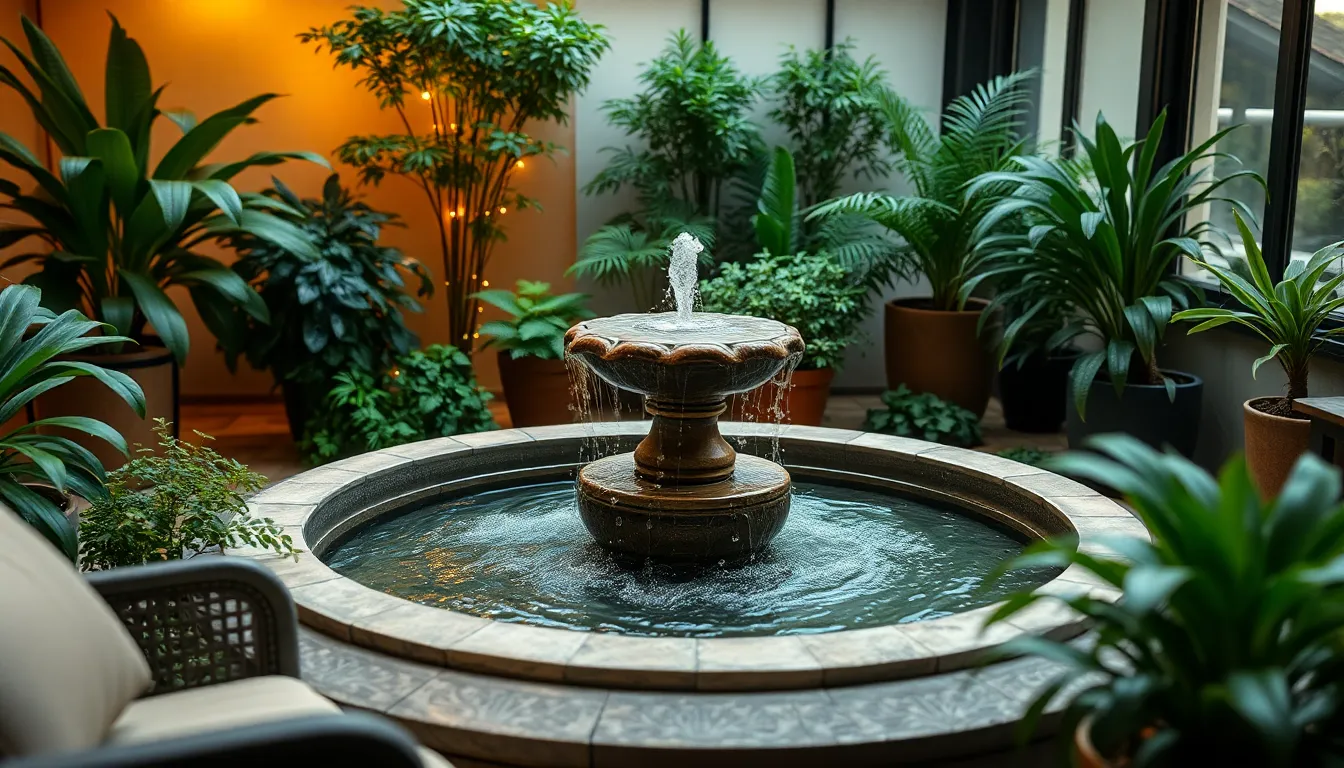
Water elements transform garden rooms into peaceful sanctuaries by introducing the calming sounds of flowing water while creating stunning visual focal points.
Install a Small Indoor Fountain
Small indoor fountains bring immediate serenity to your garden room with their gentle bubbling sounds and elegant presence. We recommend choosing tabletop models for compact spaces or floor standing versions for larger rooms that need dramatic focal points. Position your fountain near seating areas where you’ll spend the most time reading or relaxing to maximize the therapeutic benefits of flowing water.
Maintenance becomes effortless when you select fountains with recirculating pumps that require minimal water refills. Modern electric fountains offer adjustable flow settings so you can customize the sound level from soft whispers to gentle babbling streams. Consider models with LED lighting features that illuminate the water movement during evening hours.
Create a Mini Pond With Aquatic Plants
Mini ponds with aquatic plants establish natural ecosystems right inside your garden room while providing visual depth and organic beauty. We suggest using large ceramic or stone containers that complement your existing decor and can support both water plants and small decorative fish if desired. Water lilies and lotus plants create stunning surface coverage while submerged plants like hornwort help maintain water clarity.
Aquatic gardens require consistent water temperatures and adequate lighting to thrive throughout different seasons. Position your mini pond near windows or supplement with grow lights to ensure healthy plant development. Regular water testing and occasional plant trimming keep these living water features looking their absolute best.
Add a Water Wall Feature
Water wall features provide dramatic vertical elements that serve as both room dividers and striking artistic installations in larger garden rooms. We recommend installing these against sturdy interior walls where the flowing water creates mesmerizing patterns while generating consistent background sounds. Stone slate or smooth river rock surfaces work exceptionally well for creating varied water flow patterns.
Professional installation ensures proper waterproofing and pump systems that operate reliably without flooding concerns. Consider incorporating subtle lighting behind the water flow to create enchanting evening ambiance that highlights the movement and texture. These impressive features often become conversation starters while maintaining the peaceful atmosphere essential for garden room retreats.
Incorporate Natural Materials and Textures
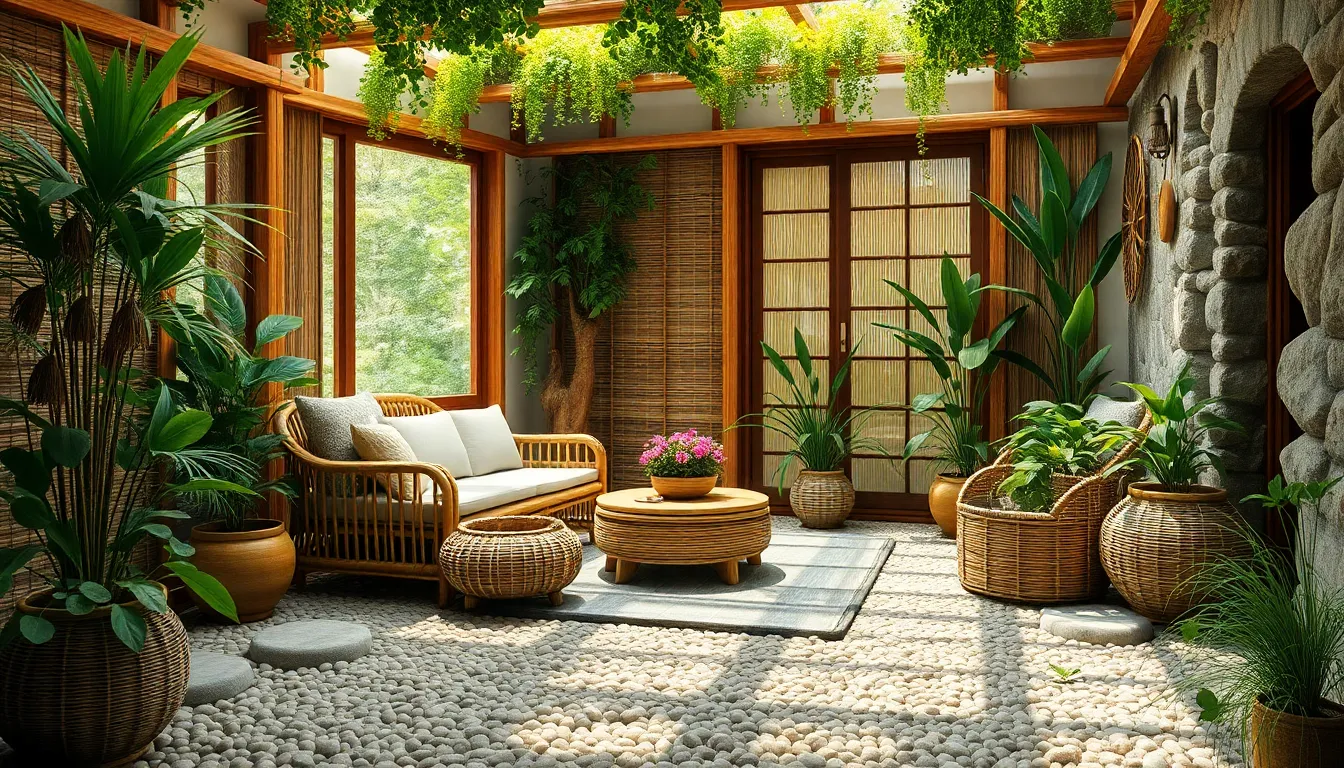
Natural materials create the foundation for an authentic garden room that feels connected to the outdoor environment. We’ll explore how organic textures like wood, wicker, rattan, and untreated fabrics can transform your space into a warm sanctuary.
Use Stone Accents for Walls and Flooring
Stone accents bring durability and grounding energy to garden rooms while maintaining that essential natural aesthetic. We recommend installing stone walls or cladding to create a cool, earthy backdrop that complements both traditional and modern design themes.
Flooring options like stone tiles or pebble surfaces add texture underfoot while providing practical benefits. These materials naturally regulate temperature and create visual interest through their varied patterns and colors. Stone flower beds positioned inside your garden room serve as unique planters that blur the lines between indoor and outdoor spaces.
Pebble pathways leading to your garden room entrance enhance the transitional experience. We suggest using local stone varieties to ensure your space feels authentically connected to its surroundings while requiring minimal maintenance.
Add Bamboo Elements for Tropical Vibes
Bamboo furniture pieces instantly infuse garden rooms with relaxed, tropical atmosphere while supporting sustainable design principles. We love incorporating bamboo chairs, tables, and shelving units because they’re lightweight yet durable, making rearrangement effortless.
Wall panels crafted from bamboo create stunning focal points that filter light naturally. These panels work beautifully as room dividers or accent walls, adding vertical interest without overwhelming smaller spaces. Bamboo’s natural color variations complement green plants perfectly, creating harmonious color schemes.
Decorative accessories like bamboo wind chimes, picture frames, and planters add subtle tropical touches throughout your garden room. We recommend bamboo blinds for window treatments because they provide privacy while maintaining that organic aesthetic you’re cultivating.
Include Woven Baskets for Storage and Decoration
Woven baskets made from natural fibers like seagrass, jute, and rattan serve dual purposes as both functional storage and decorative elements. We suggest grouping baskets of different shapes and sizes to create layered, casual arrangements that enhance your garden room’s cozy atmosphere.
Storage answers become design features when you choose baskets for organizing gardening tools, extra cushions, or reading materials. These containers add warmth and texture to any corner while keeping your space tidy and organized. Large floor baskets work perfectly for storing blankets or outdoor cushions between seasons.
Hanging woven baskets create vertical storage opportunities while adding visual interest to walls. We recommend mounting them at varying heights to display small plants, candles, or seasonal decorations that reinforce your garden room’s natural theme.
Create Functional Storage Solutions
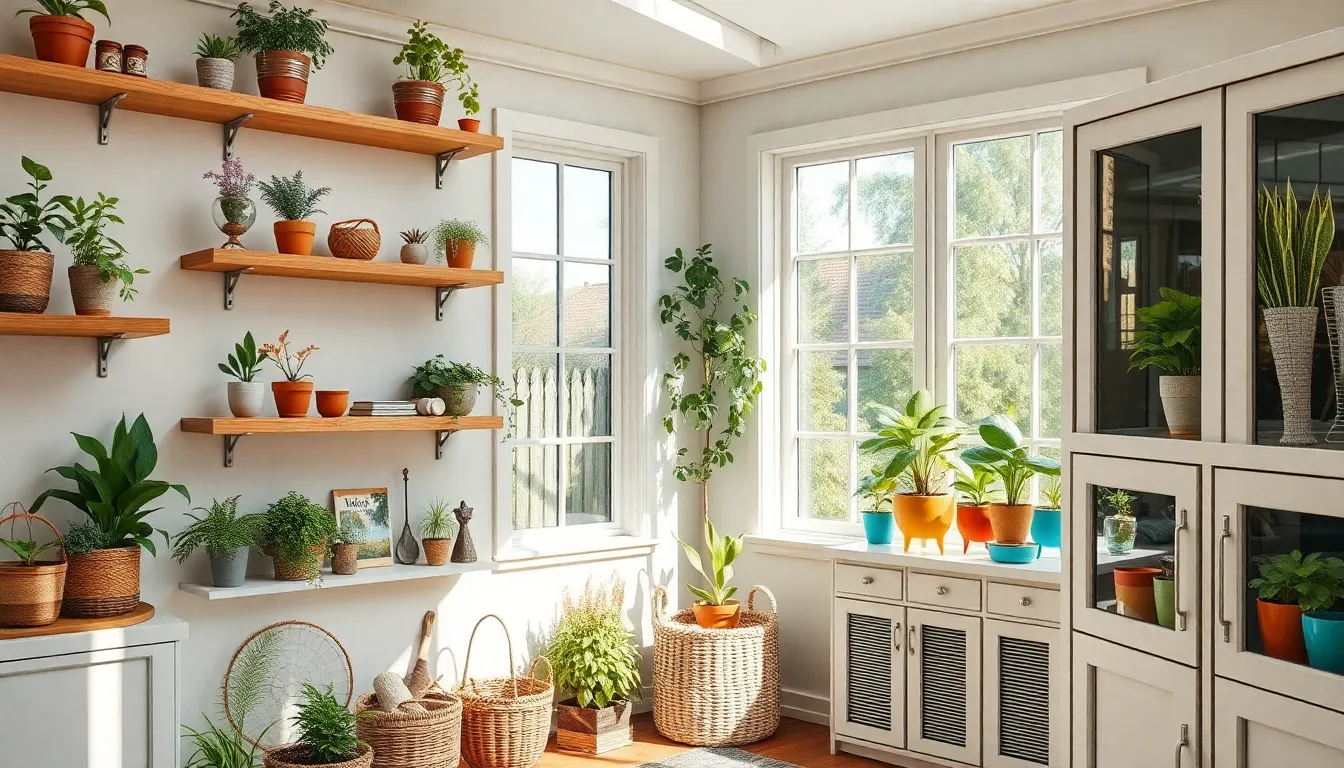
Smart storage transforms garden rooms into organized retreats that seamlessly blend beauty with practicality. We’ll explore three proven approaches that maximize space while maintaining the natural charm that makes these spaces so appealing.
Install Floating Shelves for Display and Organization
Floating shelves create visual openness while providing essential storage that keeps floor space clear and uncluttered. We recommend installing them at varying heights to display plants, decorative items, and books that reflect your garden room’s personality. Staggered arrangements work particularly well because they create ever-changing visual interest without overwhelming the space.
Position shelves near windows where natural light can highlight your displayed collections and create beautiful shadows throughout the day. Wooden shelves complement rustic themes while sleek metal options enhance modern minimalist designs. Weight distribution becomes crucial when displaying heavier items like ceramic planters or hardcover books.
Use Decorative Baskets and Containers
Baskets and buckets offer charming storage answers that add rustic character while organizing gardening tools, magazines, and seasonal accessories. We suggest choosing woven materials like rattan or bamboo that align with natural garden room aesthetics and provide excellent durability for everyday use.
Large floor baskets work perfectly for storing throw blankets and cushions when they’re not in use. Smaller containers can hold seed packets, hand tools, or create supplies on shelves and tables. Metal buckets with weathered finishes create vintage appeal while serving as planters or storage for long handled tools.
Group containers in odd numbers for visual balance and choose varied sizes to accommodate different storage needs throughout your garden room.
Build Custom Cabinetry That Matches Your Theme
Custom cabinetry provides the ultimate storage solution by maximizing every inch of available space while maintaining perfect harmony with your chosen design theme. We recommend incorporating features like adjustable shelving, soft close hinges, and integrated lighting that enhance both functionality and aesthetics.
Built in units can house everything from potting supplies to entertainment systems while maintaining clean lines that don’t disrupt your garden room’s flow. Consider adding glass front panels to display beautiful items while protecting them from dust and moisture.
Match cabinet finishes to existing elements like window frames or flooring to create cohesive design continuity. Include specialized compartments for frequently used items such as watering cans, pruning shears, and plant food that need easy access but organized storage.
Add Artwork and Decorative Accessories
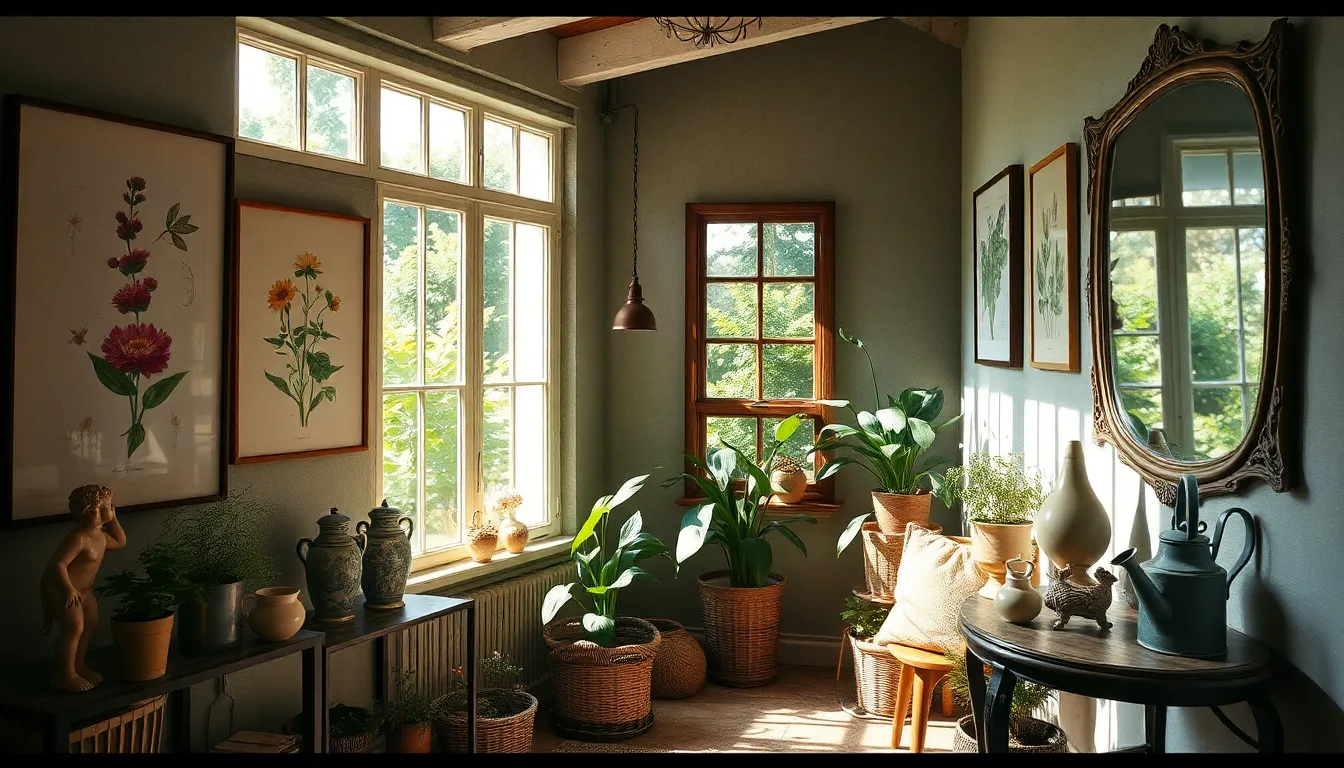
Transforming your garden room with carefully chosen artwork and decorative accessories creates visual interest while strengthening the connection between indoor comfort and outdoor beauty. We’ll explore three essential approaches that enhance both aesthetics and functionality.
Hang Nature-Inspired Paintings and Prints
Nature-inspired paintings and prints create a seamless transition between your garden room’s interior and the surrounding industry. Botanical prints featuring local flora establish an immediate connection with your outdoor space while adding educational value to the walls. We recommend positioning these artworks at eye level to maximize their visual impact and create conversation starters for guests.
Industry paintings that mirror your garden’s seasonal changes bring ever-changing beauty throughout the year. Consider watercolor pieces that capture the soft, organic feel of natural environments, or choose photography prints that showcase macro details of flowers, leaves, and textures. These visual elements reinforce the garden room’s purpose as a nature-focused retreat.
Display Sculptural Elements and Garden Ornaments
Sculptural elements add three-dimensional personality to your garden room while creating focal points that draw the eye. Garden statues made from weather-resistant materials like cast stone or ceramic work beautifully indoors and can transition outdoors during warmer months. We suggest selecting pieces that complement your chosen design theme, whether that’s classical urns for traditional spaces or modern abstract forms for contemporary garden rooms.
Decorative garden ornaments serve dual purposes as both art and conversation pieces. Vintage watering cans, ornate bird cages, or handcrafted pottery create charming vignettes when grouped on shelves or side tables. These accessories tell stories about your gardening passion while adding texture and visual weight to lighter furnishings.
Include Mirrors to Reflect Light and Create Space
Mirrors strategically placed throughout your garden room reflect natural light while creating the illusion of expanded space. Large mirrors positioned opposite windows double the amount of sunlight filtering into the room and provide glimpses of your garden from multiple angles. We recommend choosing frames that complement your decorative theme, such as weathered wood for rustic designs or sleek metal for modern spaces.
Smaller decorative mirrors can be grouped to create gallery walls that add sparkle and movement to quieter corners. Vintage hand mirrors or ornate garden-themed frames contribute to the room’s personality while serving the practical purpose of bouncing light into darker areas. This technique makes even compact garden rooms feel more expansive and bright.
Control Temperature and Climate for Year-Round Comfort
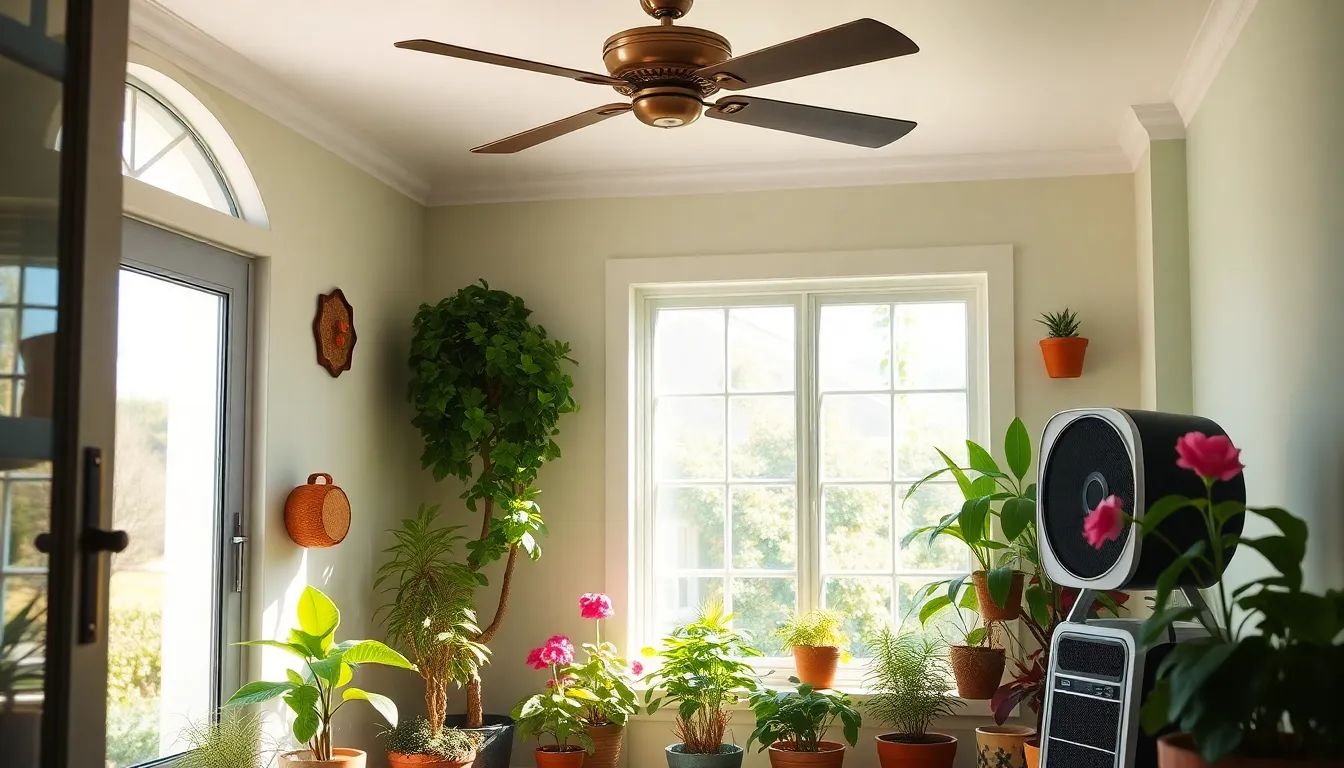
Creating a garden room that remains comfortable throughout all seasons requires strategic climate control answers. We’ve found that maintaining optimal temperature and air quality transforms these spaces into true year-round retreats.
Install Ceiling Fans for Air Circulation
Ceiling fans provide essential airflow that keeps our garden rooms fresh and comfortable during warmer months. Installing these fixtures creates consistent air movement that prevents stuffiness and helps regulate temperature naturally. We recommend choosing fans with reversible motor functions to push warm air down in winter and pull it up in summer.
Position ceiling fans centrally in the room for maximum coverage, ensuring at least 8 feet of clearance from the floor. Variable speed controls allow us to adjust airflow based on seasonal needs and personal comfort preferences. Modern ceiling fans with integrated lighting fixtures serve dual purposes while maintaining the room’s aesthetic appeal.
Add Space Heaters for Winter Warmth
Space heaters make our garden rooms usable throughout colder seasons by providing targeted warmth where we need it most. Portable electric heaters offer flexibility for occasional use, while fixed installations create consistent heating zones for regular winter activities. We suggest choosing models with automatic shut-off features and tip-over protection for safety.
Infrared heaters work particularly well in garden rooms because they warm objects and people directly rather than just heating air. Oil-filled radiator heaters provide gentle, consistent warmth that won’t dry out our plants or create uncomfortable hot spots. Consider the room’s insulation levels when selecting heater capacity to ensure efficient operation.
Include Humidifiers for Plant Health
Humidifiers maintain optimal moisture levels that support both plant health and human comfort in our garden rooms. These devices prevent the dryness that can harm greenery, especially during winter months when heating systems reduce indoor humidity. We recommend cool mist humidifiers for year-round use as they won’t raise room temperature unnecessarily.
Monitor humidity levels with digital hygrometers to maintain the ideal 40-60% range for most plants and comfortable living. Ultrasonic humidifiers operate quietly and efficiently, making them perfect for peaceful garden room environments. Regular cleaning and maintenance of humidifiers prevents mold growth and ensures consistent performance throughout the seasons.
Conclusion
Creating your perfect garden room sanctuary requires thoughtful planning and attention to detail. We’ve explored many possibilities from choosing design themes that reflect your personality to incorporating living elements that blur the lines between indoor and outdoor spaces.
The key lies in balancing functionality with aesthetics while ensuring year-round comfort through proper climate control and lighting answers. Whether you’re drawn to bohemian vibrancy minimalist elegance or rustic farmhouse charm the foundation remains the same: natural materials comfortable seating and strategic storage.
Remember that your garden room should evolve with your needs and preferences. Start with the essentials like seating and lighting then gradually add decorative touches water features and living elements that speak to your vision.
Transform your space into the peaceful retreat you’ve always envisioned where every element works together to create your personal haven.
Frequently Asked Questions
What is a garden room?
A garden room is a personal retreat space that combines the comfort of indoor living with the tranquility of nature. It can be a new addition to your home or a transformation of an existing area, designed to create a unique environment that serves as a beautiful sanctuary connecting indoor and outdoor spaces.
What are the most popular design themes for garden rooms?
The three most popular design themes are Bohemian (featuring vibrant textiles, eclectic patterns, and lush greenery), Modern Minimalist (emphasizing clean lines, neutral tones, and functionality), and Rustic Farmhouse (celebrating natural materials, vintage accents, and warm earth tones). Each theme offers unique ways to personalize your space.
How can I create comfortable seating in my garden room?
Create comfortable seating by adding plush outdoor cushions and throw pillows for warmth and texture, installing built-in benches with hidden storage for functionality, or positioning hanging chairs and swing seats for a serene atmosphere. Use weather-resistant materials and ensure strategic placement for optimal comfort.
What types of plants work best in garden rooms?
Incorporate vertical gardens on interior walls to maximize green space, use potted plants of various heights and textures for visual depth, and consider an indoor herb garden for both beauty and culinary benefits. These living elements purify air and create a sensory connection with nature.
How should I light my garden room?
Use three essential lighting strategies: hang string lights for magical evening ambiance, add floor lamps with warm LED bulbs for targeted lighting, and install skylights or large windows to maximize natural light. This combination ensures your garden room functions beautifully both day and night.
Can I add water features to my garden room?
Yes! Consider installing small indoor fountains with recirculating pumps for easy maintenance, creating mini ponds with aquatic plants for natural ecosystems, or adding dramatic water wall features that serve as artistic installations and room dividers while enhancing tranquility and sound.
What natural materials should I use in my garden room?
Incorporate organic materials like wood, wicker, and rattan furniture, stone accents for walls and flooring, bamboo elements for a tropical vibe, and woven baskets made from natural fibers. These materials create an authentic connection to the outdoors while providing durability and warmth.
How can I maximize storage in my garden room?
Install floating shelves at varying heights for display and organization, use decorative baskets and containers made from natural materials for charming storage solutions, and consider building custom cabinetry that matches your design theme with features like adjustable shelving and integrated lighting.
What type of artwork works best in garden rooms?
Choose nature-inspired paintings and prints to create seamless connection with the outdoor environment, display sculptural elements and garden ornaments for personality, and incorporate mirrors to reflect light and create the illusion of more space. These elements enhance visual appeal while strengthening the nature-focused theme.
How do I maintain year-round comfort in my garden room?
Install ceiling fans for proper air circulation and temperature regulation, use space heaters (portable or fixed) for winter warmth, and add humidifiers to maintain optimal moisture levels for both plant health and human comfort. These climate control solutions ensure your garden room remains inviting throughout all seasons.

